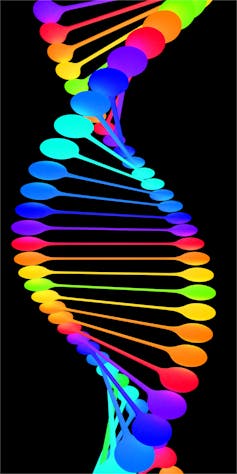When Does the Obygn Determine Sex of Baby
Across cultures, two% to 10% of people report having same-sex relations. In the U.S., one% to two.two% of women and men, respectively, place every bit gay. Despite these numbers, many people nevertheless consider homosexual beliefs to exist an anomalous choice. However, biologists take documented homosexual behavior in more 450 species, arguing that same-sex activity behavior is non an unnatural option, and may in fact play a vital role inside populations.
In a 2019 result of Scientific discipline magazine, geneticist Andrea Ganna at the Broad Institute of MIT and Harvard, and colleagues, described the largest survey to date for genes associated with aforementioned-sex behavior. By analyzing the DNA of nearly one-half a meg people from the U.S. and the U.Thou., they concluded that genes account for betwixt viii% and 25% of same-sex behavior.
Numerous studies have established that sex is not only male or female person. Rather, it is a continuum that emerges from a person's genetic makeup. Nonetheless, misconceptions persist that same-sex attraction is a pick that warrants condemnation or conversion, and leads to discrimination and persecution.
I am a molecular biologist and am interested in this new study as it further illuminates the genetic contribution to man beliefs. As the author of the volume, "Pleased to Meet Me: Genes, Germs, and the Curious Forces That Make U.s. Who We Are," I take done all-encompassing research into the biological forces that conspire to shape homo personality and behavior, including the factors influencing sexual attraction.
The hunt for 'gay genes'
The new finding is consistent with multiple earlier studies of twins that indicated same-sex attraction is a heritable trait.

The 2019 written report is the latest in a chase for "gay genes" that began in 1993, when Dean Hamer linked male person homosexuality to a section of the X chromosome. As the ease and affordability of genome sequencing increased, boosted gene candidates have emerged with potential links to homosexual beliefs. So-called genome-wide association studies identified a gene chosen SLITRK6, which is active in a brain region called the diencephalon that differs in size between people who are homosexual or heterosexual.
Genetic studies in mice take uncovered additional gene candidates that could influence sexual preference. A 2010 report linked sexual preference to a gene chosen fucose mutarotase. When the gene was deleted in female mice, they were attracted to female odors and preferred to mount females rather than males.
Other studies take shown that disruption of a gene called TRPC2 can crusade female person mice to act like males. Male mice lacking TRPC2 no longer display male person-male aggression, and they initiate sexual behaviors toward both males and females. Expressed in the brain, TRPC2 functions in the recognition of pheromones, chemicals that are released by one fellow member of a species to arm-twist a response in another.
With multiple gene candidates being linked to homosexuality, it seemed highly unlikely that a single "gay" gene exists. This thought is further supported by the new written report, which identified 5 new genetic loci (fixed positions on chromosomes) correlating with aforementioned-sex activity activity: two that appeared in men and women, two only in men, and 1 only in women.
How might these genes influence same-sex beliefs?
I find it intriguing that some of the genes from men identified in Ganna'southward report are associated with olfactory systems, a finding that has parallels to the work in mice. Ganna's group plant other factor variants that may be linked with sex hormone regulation, which other scientists have previously suggested plays a large office in shaping the encephalon in ways that influence sexual beliefs.

Males with a genetic condition called androgen insensitivity syndrome can develop female ballocks and are usually brought up as girls, despite existence genetically male – with an 10 and Y chromosome – and they are attracted to men. This suggests that testosterone is needed to "masculinize" a prenatal encephalon; if that doesn't happen, the child volition grow up to want men.
Similarly, girls who accept a genetic condition called congenital adrenal hyperplasia are exposed to unusually high levels of male hormones like testosterone while in the womb, which may masculinize their brain and increase the odds of lesbianism.
Information technology'south likewise possible that hormonal shifts during pregnancy could impact how a fetus' brain is configured. In rats, manipulation of hormones during pregnancy produces offspring that exhibit homosexual beliefs.
Why does homosexual behavior exist?
Several hypotheses have been advanced to explicate how homosexuality can be benign in perpetuating familial genes. I idea involves the concept of kin selection, whereby people piece of work to ensure the passage of their family's genes into subsequent generations. Gay uncles and aunts, for example, are "helpers in the nest" that help raise other family members' children to nurture the family tree.
Another thought suggests that homosexuality is a "trade-off trait." For instance, certain genes in women help increase their fertility, but if these genes are expressed in a male, they predispose him toward homosexuality.
Sexual behavior is widely diverse and governed by sophisticated mechanisms throughout the animal kingdom. As with other circuitous behaviors, it is non possible to predict sexuality past gazing into a DNA sequence every bit if it were a crystal brawl. Such behaviors emerge from constellations of hundreds, perhaps thousands, of genes, and how they are regulated by the environment.
While there is no single "gay gene," in that location is overwhelming testify of a biological basis for sexual orientation that is programmed into the brain before nascency based on a mix of genetics and prenatal atmospheric condition, none of which the fetus chooses.
[ You're smart and curious well-nigh the world. So are The Conversation's authors and editors. You tin read united states of america daily by subscribing to our newsletter. ]
collinsdoingunt93.blogspot.com
Source: https://theconversation.com/stop-calling-it-a-choice-biological-factors-drive-homosexuality-122764
0 Response to "When Does the Obygn Determine Sex of Baby"
Post a Comment